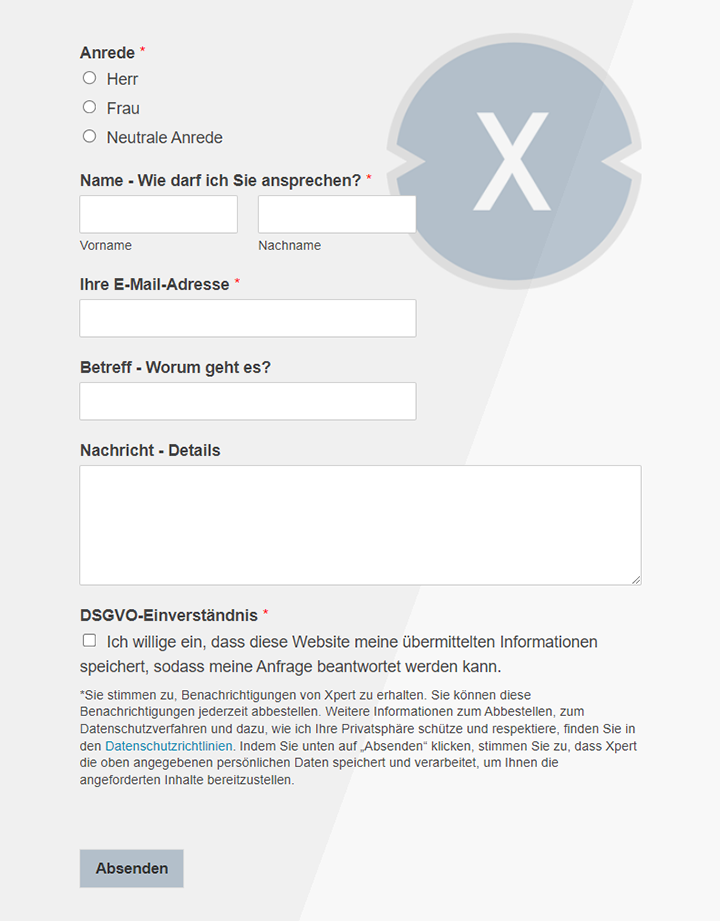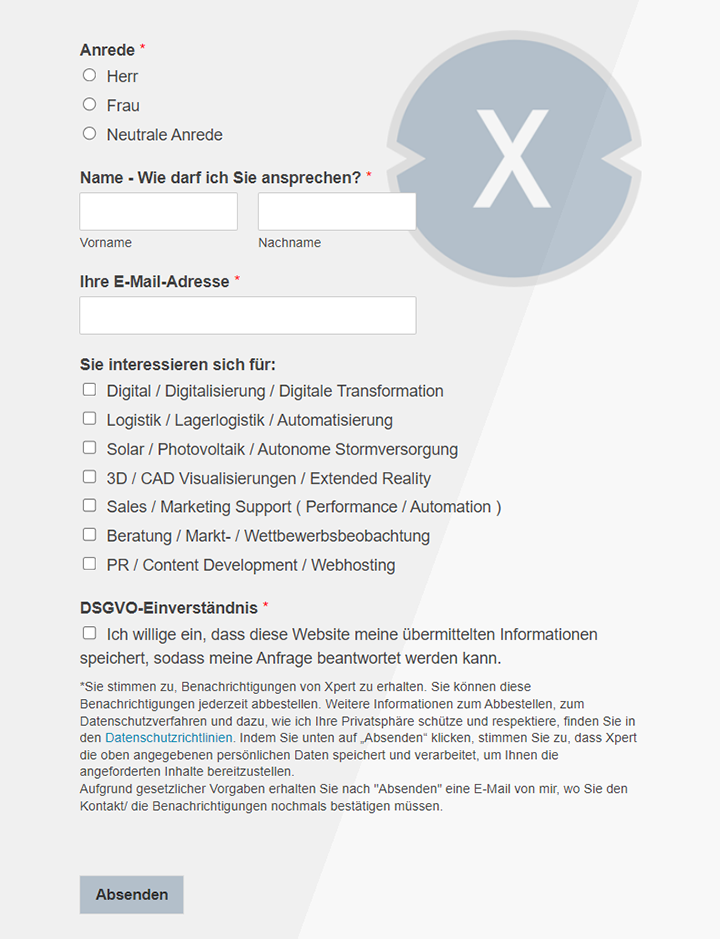Where the Internet lives – the invisible Google: This is how the data centers for search engine rankings run in secret
Xpert pre-release
Language selection 📢
Published on: January 24, 2025 / update from: January 24, 2025 - Author: Konrad Wolfenstein

Where the internet lives - the invisible Google: The data centers for the sush machines rankings in a hidden - picture: xpert.digital are running
Google's data centers: A look behind the scenes of the digital giants - research
How Google connects the world: technological masterpieces and sustainable innovations
Google is an integral part of modern everyday life. Whether for searches, videos, cloud services or emails-the services of the technology company have become an indispensable part of our lives. But behind this smooth use is an impressive technological infrastructure: Google's data centers. These state -of -the -art systems form the company's backbone and ensure that billions of inquiries can be processed worldwide within seconds. This article offers a comprehensive insight into the number, locations, functionality, safety precautions and the sustainability efforts of these data centers.
The global presence of the Google calculation centers
Google operates a variety of data centers worldwide to offer its users fast and reliable services. Current estimates speak of over 40 data centers in more than 12 countries. These are located in strategic locations to ensure optimal network cladding and regional availability. The locations are chosen so that they offer both a stable power supply and a good connection to the Internet.
Examples of prominent locations:
- USA: With locations such as Iowa, South Carolina, Georgia, and Oregon, the USA is the heart of the Google infrastructure. The data center in The Dalles, Oregon, which is one of the company's first and largest facilities, is particularly well known.
- Europe: In Europe, Google operates state -of -the -art data centers in Dublin (Ireland), St. Ghislain (Belgium) and Fredericia (Denmark). These locations not only support European users, but also contribute to fulfilling regional data protection regulations such as the GDPR.
- Asia: In Changhua County (Taiwan) and Singapore, Google maintains data centers in order to meet the growing demand for digital service in the region.
- South America: The data center in Quilicura, Chile, is an important hub for users in Latin America.
Overview of the Google data center:
The exact number and exact locations often remain confidential for security reasons, but it is known that Google continuously expands the locations of its data centers in order to keep up with increasing demand.
Size and capacity: giants of the digital world
Google data centers are not only characterized by their global distribution, but also by their immense size and capacity. A typical data center extends over an area of 100,000 to 1,000,000 square foot (approx. 9,290 to 92,900 square meters). The largest systems, such as the data center in Mayes County, Oklahoma, achieve a capacity of over 1 million square foot.
The infrastructure comprises millions of servers that are housed in specially developed server corns. Gartner estimated in 2016 that Google already had over 2.5 million servers in operation at this point - a number that has been increasing significantly since then. These servers process billions of search queries every day, save data and operate services such as YouTube and Google Maps.
The technological infrastructure of the data centers
Google's data centers are equipped with the most advanced technologies in order to make the processing of data as efficiently as possible. Here is an overview of the key technologies:
1. Server architecture
Google develops many of its servers itself to optimally tailor the hardware to the specific requirements of its services.
- Web server: Edit user inquiries and forward to the index servers.
- Index server: Manage the search index and search for relevant information.
- Document server: Save website content and deliver them to the users.
2. Network technology
The data centers are connected by Google's own network infrastructure, including the proprietary technologies Jupiter Fabric and WAN B4. These networks offer a wide range and low latency, which is crucial for services such as YouTube and Google Cloud.
3. Cooling and energy efficiency
The servers generate enormous amounts of heat, which is why Google uses innovative cooling systems. This includes:
- Evaporation cooling: Cold air is generated by the evaporation of water.
- Outside air cooling: In regions with a cool climate, the outside air is used for cooling.
These measures contribute to significantly reducing energy consumption and supporting the company's sustainability goals.
More about it here:
4. Software innovations
Google uses its own software solutions such as the Google File System (GFS) and Bigtable, which were specially developed for the processing of large amounts of data. These technologies ensure that data can be saved, accessed and processed efficiently.
Security measures: protection at the highest level
The safety of the stored data is a top priority for Google. In order to ward off both physical and digital attacks, the company relies on a multi -stage security concept:
- Physical security: data centers are protected by biometric authentication, access controls and video surveillance. Security personnel are in use around the clock.
- Data encryption: All data is encrypted both during the transmission and in idle state.
- Distribution of the data: Data is divided into small blocks and stored at various locations in order to intercept a failure of individual systems.
Sustainability: Google's commitment to the environment
Google has set itself ambitious goals to minimize the environmental impact of its data centers. Here are some of the most important initiatives:
1. Energy efficiency
Google's data centers are an average of 1.8 times as energy-efficient as conventional corporate calculation centers. Through measures such as the use of outside air to cool and the use of one's own energy -efficient server, Google was able to reduce the proportion of energy consumption that is not used directly for calculation.
2. Renewable energy
Google plans to operate its data centers exclusively with carbon -free energy by 2030. To this end, the company is investing in solar and wind energy projects and concludes long-term acceptance agreements with energy producers.
3. Water consumption
Since cooling systems need large amounts of water, Google is working to reduce consumption. Some systems use recycled wastewater or rainwater to minimize fresh water consumption.
The role of data centers in search engine operation
The data centers are the heart of the Google search engine. You save and process the search index, a gigantic database that contains information about the billions of websites. With the help of powerful servers and innovative algorithms, Google searches this index in a matter of seconds to provide relevant results for user inquiries.
This is how it works:
- Crawler search the web and add new content to the index.
- The index is analyzed in order to be able to access relevant information efficiently.
- Search queries are processed by comparing the information in the index.
- The results are compiled and presented in a user -friendly way.
Google's data centers as the heart and engine of the digital world
The Google data centers are much more than just gigantic server halls. They are a symbol of technological innovation, efficiency and sustainability. Due to the continuous further development of its infrastructure and the use of the latest technologies, Google sets new standards in the industry. At the same time, the company shows that economic success and environmental awareness can go hand in hand. With these data centers, Google laid the foundation for a digital future that is quick, safe and sustainable.
Suitable for:
Our recommendation: 🌍 Limitless reach 🔗 Networked 🌐 Multilingual 💪 Strong sales: 💡 Authentic with strategy 🚀 Innovation meets 🧠 Intuition
At a time when a company's digital presence determines its success, the challenge is how to make this presence authentic, individual and far-reaching. Xpert.Digital offers an innovative solution that positions itself as an intersection between an industry hub, a blog and a brand ambassador. It combines the advantages of communication and sales channels in a single platform and enables publication in 18 different languages. The cooperation with partner portals and the possibility of publishing articles on Google News and a press distribution list with around 8,000 journalists and readers maximize the reach and visibility of the content. This represents an essential factor in external sales & marketing (SMarketing).
More about it here:
How Google's global infrastructure shapes our everyday life - insights into the power of the data center - background analysis
Google's data center: the heart of the search engine and more
Google is much more than just a search engine. It is an ecosystem that penetrates our everyday life-from emails to video streaming to complex cloud services. This global network of services is supported by an invisible but impressive infrastructure: the Google data centers. These state -of -the -art systems that extend over the entire globe are the backbone of the digital empire of Google and form the basis for all the services that we use every day.
The global distribution of the data: a question of closeness and efficiency
The exact number of data centers operated by Google is a well -kept secret. The information vary depending on which source you use. Estimates speak from 30 to over 40 locations worldwide, with the number constantly changing. This is because Google continuously expands its capacities and puts new centers into operation, while older systems are modernized or adapted. The different figures can often be attributed to different definitions of "data center", which sometimes include individual buildings, sometimes entire campuses.
However, Google's strategy in choosing the location is anything but arbitrary. It follows a clear pattern: closeness to the users and optimization of performance. The goal is to process search queries and other data as close as possible to the user in order to minimize the latency and to shorten the response times. This means that Google data centers are strategically placed in regions with high use density. Therefore, the distribution of the data center is not even, but follows the global patterns of internet use and data traffic.
An interesting aspect of the data center strategy is the division into "regions" and "availability zones". A region is a geographical area in which one or more data centers are located. An availability zone, on the other hand, is an isolated unit within a region that has an independent power supply, cooling and network connection. This separation enables Google to increase the failure safety of its services, since a failure in a zone does not automatically affect other zones or the entire region. Redundance is a key element of the Google infrastructure, and the availability zones play a crucial role.
Where the data lives: an incomplete world map of the Google data center
While Google does not make the exact locations of its data centers public, some locations have become known. Here is an overview based on publicly accessible information, whereby the actual number of locations is probably higher:
North America:
- USA: Google has a strong presence in the United States, with data centers in South Carolina (Berkeley County), Iowa (Council Bluffs), Georgia (Douglas County), Nevada (Henderson), North Carolina (Lenoir), Alabama (Jackson County) , Virginia (Loudoun County), Oklahoma (Mayes County), Tennessee (Montgomery County), Texas (Midlothian), Ohio (New Albany), Nebraska (Papillion) and Oregon (The Dalles). These locations are strategically chosen to cover the different regions of the United States and to ensure a high redundancy.
South America:
- Chile: In Quilicura, Google operates a data center to serve the growing demand in South America.
Europe:
- Ireland: Dublin is an important location for Google in Europe.
- Netherlands: There is another important data center in Eemshaven.
- Denmark: Google also operates a data center in Fredericia.
- Finland: Another data center is located in Hamina that benefits from the cool environment.
- Belgium: St. Ghislain is also an important hub in Google's European network.
Asia:
- Taiwan: Changhua County is an important data center location in Asia.
- Japan: Inzai is another important hub in Asia.
- Singapore: Singapore serves as a hub for Southeast Asia.
It is important to emphasize that this list is not final and other locations can exist that are not publicly known. The global distribution of the Google data centers reflects the global nature of its services and the need to store and process data close to the user.
The dimensions of the data: gigantic areas and server farms
The size and capacity of Google's data centers are immense. The exact dimensions are difficult to grasp, since Google treats this information strictly confidentially. However, it is known that Google invests considerable sums in the construction and modernization of its data centers.
Some of the best known data centers, such as Lenoir (North Carolina), have an area of over 9,000 square meters. However, this size is only a small fraction of the largest Google data center. The facility in Mayes County, Oklahoma, was once the largest known data center with over 90,000 square meters, although it has now been exceeded by others.
The construction costs for these systems are also enormous. In North Carolina, Google is investing around $ 3,000 per square foot-an amount that exceeds the triple costs of developing premium data centers. This underlines the meaning that Google supports its data centers. They are not only deposits for data, but also the foundation for the company's web -based services and advertising products.
The number of servers in these data centers is also impressive. Estimates from 2016 spoke of around 2.5 million servers, but this number has increased significantly since then, since Google continuously expands its capacities. These servers are not just standard hardware. Google develops its own server, optimized for specific tasks and the needs of its services. These tailor-made servers are energy-efficient and powerful and play an important role in maintaining the smooth operation of the Google network.
From the garage to the global network: the beginnings of the Google infrastructure
The beginnings of the Google data centers were modest. The first servers that Larry Page and Sergey Brin used at Stanford University were a colorful mix of various hardware components. This included Sun Microsystems Ultra II-Server, Intel Pentium II-Server, IBM RS/6000 computers and a variety of hard disk housings. This hardware formed the basis for the original "backrub" system, the forerunner of today's Google search engine.
It is noteworthy how quickly Google's infrastructure developed. From a handful of servers in a university garage, Google has developed into a global network of data centers that operates the largest search engine in the world and a variety of other services. This development shows the continuous innovation and commitment to technological progress that Google has been driving since its beginnings.
The role of the data center in the search engine index: the logic of the search
The Google data centers play a crucial role in how the search engine works. They not only accommodate the huge search index, but also the entire infrastructure that is required for the processing of search queries and the provision of search results.
The search index is essentially a gigantic catalog of all websites that Google knows. This catalog is comparable to the catalog of a library that contains information about each book, such as the title, the author and a short summary. If you are looking for a certain book in the library, you look up in the catalog to find out where it is. Google search works in the same way: If you enter a search query, Google searches the search index for relevant websites and shows the results.
It is important to understand that the search index does not include the entire Internet. Google uses "Crawler" (also called "Spider") to find the web and find new websites that are then added to the index. According to estimates, however, there are only between 1 % and 4 % of all websites in the Google index. This shows how selectively and efficient Google is when indexing the web.
If a user asks a search query, it will be sent to the Google web servers (GWS). The GWS then forward the request to the index servers that are responsible for the management of the search index. The index servers search the index for relevant documents and create a list of document IDs. These IDs are then sent to the document servers that save the actual website content. The document servers return the content to the GWS that put together the search results and deliver to the user. This process runs in fractions of seconds, which illustrates the efficiency and speed of Google search.
Technology behind the scenes: A look into the innermost of the data center
The Google data centers use a variety of technologies to efficiently master these processes. This includes:
Server: Google uses different types of servers, each of which fulfills a certain function. There are web servers that receive search queries from users and forward to index server; Index server that manage the search index and create lists with relevant document IDs; And document servers that save the content of the website and deliver to the web server. There are also special servers for other Google services such as maps, shopping and ads.
Network technology: The data centers are equipped with high -performance networks that enable quick and reliable communication between the servers. Google has invested heavily in the development of its own network technologies in recent years. B. Jupiter Fabric and WAN B4. These technologies are crucial for the functioning of many Google services, including the search, and enable efficient communication and scalability.
Cooling technology: The servers in the data centers create enormous heat that has to be removed to avoid overheating. Google therefore relies on efficient cooling systems that minimize energy consumption. This includes the use of evaporation cooling, the cooling with outside air and the development of your own cooling technologies.
Software: Google uses a variety of software solutions to manage and process the huge amounts of data in its data centers. This includes proprietary systems such as the Google File System and Bigtable, which are specially optimized for processing large amounts of data.
Security as the top priority: the protection of the data
Google places great value on the safety of its data center and uses various measures to prevent unauthorized access to the data. This includes:
- Distribution of the data: The data is not stored on a single computer or a group of computers, but are distributed via many computers at different locations.
- Chunking and replication: The data is divided into small blocks (“chunks”) and replicated via several systems to avoid a single point of failure.
- Encryption: The data is encrypted both in the idle state and during the transmission to protect it from unauthorized access.
- Physical security: The data centers are equipped with multi -stage security systems, including access controls, cameras, biometric authentication and security personnel.
These security measures are of crucial importance to protect the integrity and confidentiality of the data of millions of users.
Focus on sustainability: Google's responsibility
Google is aware of the environmental impact of its data center and uses various measures to improve sustainability:
- Energy efficiency: Google data centers are an average of 1.8 times as energy-efficient as a typical corporate data center. Google continuously works to reduce the energy consumption of its data centers by increasing the temperature in the data centers, the use of outside air for cooling and the development of own servers.
- Renewable energies: Google has undertaken to operate its data centers around the clock with carbon -free energy around the clock. The company is investing in renewable energy sources such as solar and wind energy and is working to increase the proportion of renewable energies in its data centers.
- Water consumption: Google is working on reducing the water consumption of its data centers and relies in some systems on alternative water sources such as waste water or industrial water.
- Google's commitment to sustainability shows that the company takes its responsibility towards the environment seriously.
The hidden universe of the data
Google's data center are a fascinating example of technological innovation and the enormous logistical challenges associated with the provision of global online services. They are the heart of the Google empire and play a crucial role in functioning the search engine and many other services. The constant further development and investments in technology, security and sustainability show that Google endeavors to further optimize this infrastructure and to shape a sustainable future.
Behind every search query, every uploaded video and every email sent is the complex and impressive world of the Google data center, which are invisible but indispensable for our digital life.
We are there for you - advice - planning - implementation - project management
☑️ SME support in strategy, consulting, planning and implementation
☑️ Creation or realignment of the digital strategy and digitalization
☑️ Expansion and optimization of international sales processes
☑️ Global & Digital B2B trading platforms
☑️ Pioneer Business Development
I would be happy to serve as your personal advisor.
You can contact me by filling out the contact form below or simply call me on +49 89 89 674 804 (Munich) .
I'm looking forward to our joint project.
Xpert.Digital - Konrad Wolfenstein
Xpert.Digital is a hub for industry with a focus on digitalization, mechanical engineering, logistics/intralogistics and photovoltaics.
With our 360° business development solution, we support well-known companies from new business to after sales.
Market intelligence, smarketing, marketing automation, content development, PR, mail campaigns, personalized social media and lead nurturing are part of our digital tools.
You can find out more at: www.xpert.digital - www.xpert.solar - www.xpert.plus


























